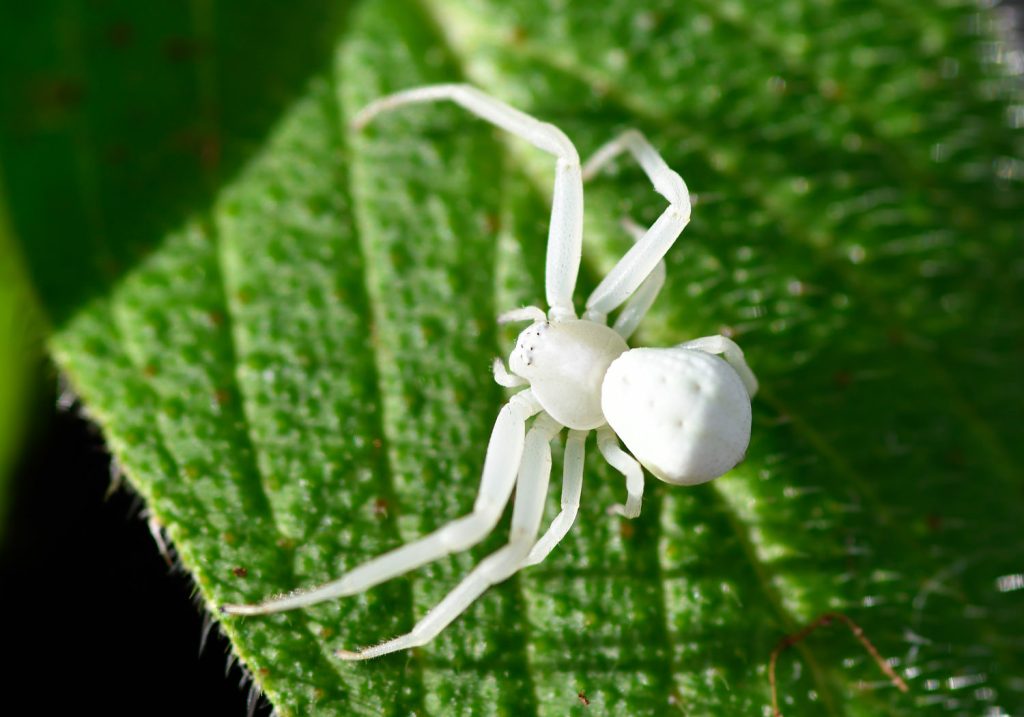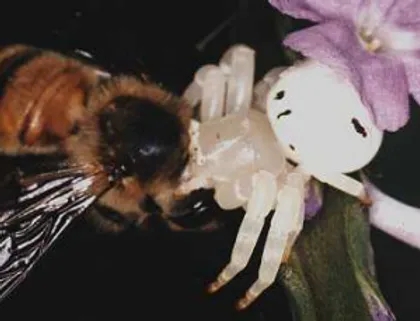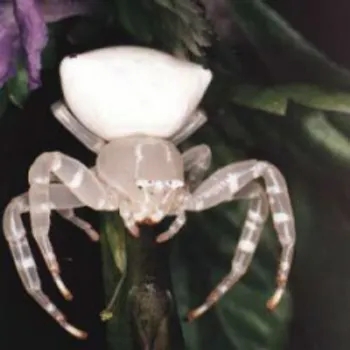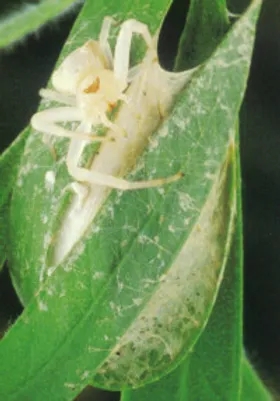The Flower Spider’s Latin name is Thomisus spectabilis. Another name for the Flower Spider is the Crab Spider because it has white or yellow stout legs which are held like a crab. The full size of the Flower Spider is between four and ten millimetres. Flower Spiders are often white or yellow in colour, some have green, brown or rosy tints on the abdomen. The females are small and their legs are less than 7mm long. The males are even smaller, but their legs are longer. They normally have two large front eyes and have very well developed eyesight.

Identifying Crab Spiders Bite
Like any arachnid bite, crab spider bites leave two puncture wounds, produced by the hollow fangs used to inject venom into their prey. Crab spiders are equipped with venom powerful enough to kill prey much larger than themselves. While their venom isn’t dangerous to humans, as crab spiders are generally too small for their bites to break the skin, giant crab spider bites can be painful. Likened to striking your fingernail with a hammer, a bite on the fingernail can be excruciatingly painful, cause discoloration to the finger, with pain from the bite reaching the hand. The bite site may also swell but the bite symptoms subside after a few hours.

When do Crab Spiders Bite
Crab spiders are very timid, non-aggressive spiders that will flee from predators, if possible, rather than stand and fight. Crab spiders don’t build webs, but they do spin flat nests for their eggs on leaves of plants. The exception to this rule happens because female crab spiders will stand guard over their nests until their eggs hatch.
What to do If You Find a Crab Spider in Your Home
Due to the crab spider’s preferred habitat, it is very unlikely to find this type of spider inside. If you do happen to find one inside though, it is recommended that you gently capture the spider by scooting it into a cup, covering it, and releasing it outside. They are not harmful to humans and are a great way to control the population of other insects like bees, wasps, mosquitoes, and flies in your yard.
Have you been bitten by a crab spider or is one lurking around your living area? First off, don’t panic; crab spiders’ venom is not poisonous to you (unless you are a bee or unless you happen to be allergic). And if you don’t know if you are dealing with a crab spider (Thomisidae), check to see if they look like a crab in that their front legs are held up and out, their 4 – 10mm bodies are a bit flatter than other spiders, and, like a crab, they are walking sideways. Also check to see if they look a bit neon in color (yellow, green, or orange) or sometimes white or brown. You probably should also stop looking for cobwebs; these crabby walkers tend to wait on foliage and on the grounds of gardens for prey.
Although you may not want to hear this, crab spiders are considered helpful for humans as they kill those pesky flies, mosquitoes, moths, and other insects (like we do!), however not many people want crab spiders habituating with them. What these crab spiders really love, however, are flowers (hence their bright colors). Like a chameleon, the crab spider can change its color to camouflage itself into the flower she is waiting on to ambush an unsuspecting insect and hide from other predators.
The crab spider will stay put in its hunting spot for days or even weeks, sometimes changing color with its surroundings. When it sees a living meal it can catch, it will drop a silk line to hunt, similar to a fisherman. Again, the crab spider can bite and will bite a human, but its venom is not harmful or poisonous.
If a crab spider is found in your house, it’s probably a mistake on its part for navigation. The crab spider most likely wants to be on a leaf, under a piece of bark, on a flower, or in the crevasse of a tree trunk in your garden. If you’ve noticed a brown-speckled, flat, crab-legged spider hanging around and need to test it to see what kind it is, gently poke it with a long stick and watch to see if it widens those long front legs and moves sideways. If it does, that will be a crab spider.
Habitat:
Each Flower Spiders takes a flower as its hunting territory and waits on the petals, anchored by its hind legs and pedipalps extended. An insect visiting the flower for pollen or nectar is seized and bitten, then sucked dry. They are mostly common in Summer and are Australia wide. They also live in the garden on native flowers, on grass heads and among seed pods and in rushes. They are common on native flowers such as Grevillea. Flower spiders are diurnal in their habits which means they are active in the day time.

Prey:
Flower Spiders feed eat insects such as butterflies and nectar feeding insects. They even eat bees as you can see from the picture below. The Flower Spider catches insects with its front legs which close together like a pair of tongs. It also jumps at the insect which lands on the flower, then eats it.
Breeding:
When the female is ready to lay her eggs, she weaves a tiny silk dish, then she lays her eggs in the tiny dish. Then she makes a silk lid to fit the dish and that is her egg sac. The eggs are like tiny green jewels that stay in the egg sac up to two weeks. When the spiderlings hatch, they are left to fend for themselves.

Venom:
Flower Spiders are quite quick to bite but only cause mild local pain to humans.
One species of Crab Spider is the Goldenrod Spider It is best known for its ability to change its colour from white to yellow in order to camouflage among flowers. The female is the one most often seen. She is either yellow or white, depending on where she is, with red streaks on her abdomen. The male is dark reddish-brown, with a whitish abdomen with dark red streaks. The male is smaller (about 1/8 inch) than the female (up to 3/8 inch). Goldenrod Spiders are found wherever there are yellow and white flowers, especially goldenrod and daisies. This is usually in a field or garden.
